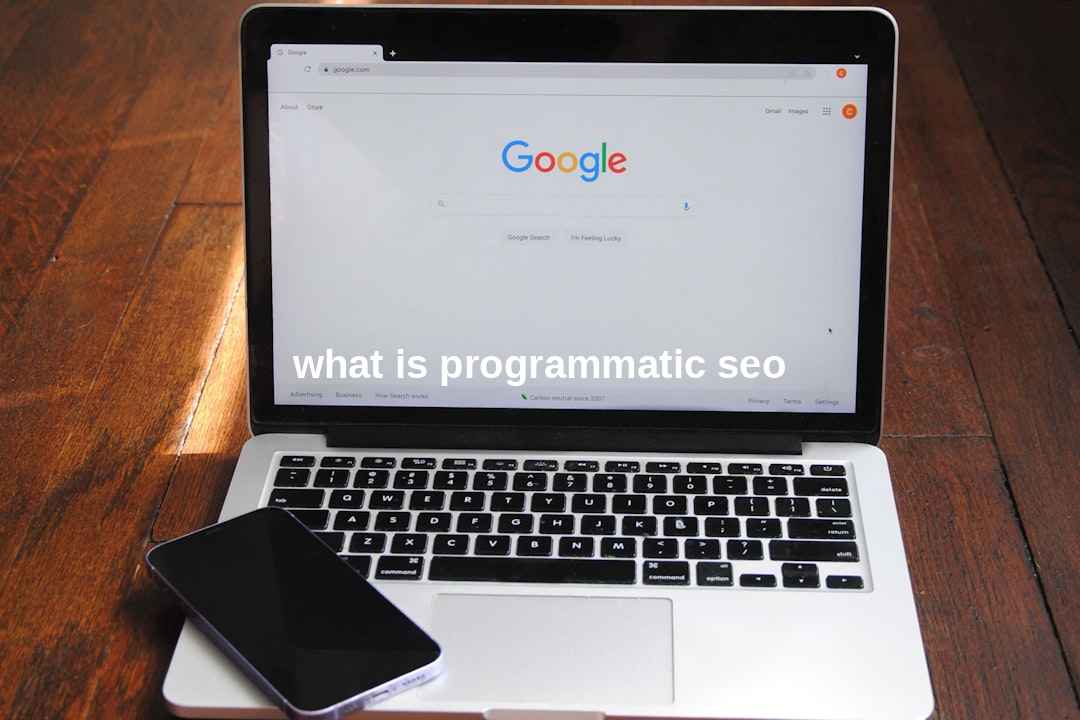Introduction:
In an ever-evolving digital marketing landscape, SEO strategists are continually seeking innovative ways to stay ahead of the competition. One such method that has garnered significant attention is programmatic SEO. This technique leverages the power of automation to generate large numbers of landing pages, each tailored to specific keywords and search intents. By doing so, it unlocks the potential for massive scale in search engine optimization, allowing businesses to target a broader range of keywords and topics than would be feasible manually. But with any form of automation, the line between high-quality content and spammy, unhelpful pages is thin. Understanding the nuances of programmatic SEO is crucial to leveraging its benefits without compromising on the quality your audience expects.
| Aspect | Detail |
|---|---|
| Sophistication | Highly sophisticated, leveraging AI and algorithms |
| Scalability | Can handle vast numbers of pages and keywords |
| Customization | Generates unique pages for each targeted keyword |
| SEO Impact | Potentially significant, if managed correctly |
The Rise of Automated Landing Page Creation
The trend towards automation in digital marketing has led to the rise of innovative tools and strategies aimed at streamlining processes and maximizing efficiency. Programmatic SEO sits at the forefront of this trend, fundamentally changing the way businesses approach the creation of landing pages.
Automating for Efficiency and Scale
In the realm of SEO, the importance of landing pages cannot be understated – they are the gateways that funnel web traffic from search engines to websites, aiming to convert visitors into customers. Traditionally, crafting these pages has been a painstaking process, involving a significant investment of time and resources to ensure each page is optimized for its intended keyword and audience.
However, with the advent of automated landing page creation, the game has changed. By utilizing sophisticated software, companies can now automatically generate landing pages, each designed with specific keyword targeting in mind. This strategy not only enhances the efficiency of page production but also exponentially increases the scale at which a business can operate within the search landscape.
As system-generated landing pages begin to saturate the market, the challenge lies in maintaining quality and relevance—a critical factor for sustaining SEO performance and user engagement. Thus, as we navigate this new horizon, the focus must be on finding the delicate balance between automation and the human touch required to produce landing pages that resonate with real users and drive genuine business results.
Unlocking Scale in SEO: Automating Keyword-Specific Pages

The primary advantage of programmatic SEO is its ability to massively scale SEO efforts. By automating the production of keyword-specific pages, businesses can target a wide array of search queries, covering more ground in the search engine results pages (SERPs) almost instantaneously.
Maximizing Reach with Tailored Content
The essence of programmatic SEO lies in its capacity to create tailored content that matches a vast variety of user intents and search terms. Each page generated is a new opportunity to rank for a targeted phrase, covering more niche areas of a business’s market that competitors may overlook.
Programmatic SEO empowers businesses to create laser-focused content at a scale that human teams simply cannot match, thereby opening gates to previously untapped market segments.
By using data-driven insights to inform the generation of these pages, businesses ensure that their content remains relevant and valuable to the user, while also signaling to search engines that the website is a rich source of information on a given topic. As a result, programmatic SEO can significantly elevate a brand’s online presence, improve organic search visibility, and drive more targeted traffic.
The Divide Between Good and Bad Automated Content
As with any form of automation, there’s a spectrum of quality when it comes to programmatic SEO. Understanding this divide and operating on the side of good, valuable automated content is key to the long-term success of SEO strategies.
Quality Content vs. Quantity of Pages
The temptation to generate countless pages can lead to an abundance of low-quality, thin, or duplicated content if not managed correctly. Search engines are incredibly adept at identifying and penalizing websites that employ such tactics, which can harm a website’s reputation and rankings.
Effective programmatic SEO balances the need for scale with the imperative of quality, ensuring that each automated page offers unique value to users and search engines alike.
Creating engaging, informative, and user-friendly content should remain the priority, even when using automated processes. High-quality automated content needs to be indistinguishable from human-written content, providing solid information, answering user questions, and maintaining brand voice and consistency.
Driving Traffic with Strategic Keyword Research and Page Optimization
Programmatic SEO isn’t solely about producing content at scale; it must be underpinned by strategic keyword research and ongoing page optimization to drive traffic effectively.
Insights That Inform Content Strategy
The foundation of any successful programmatic SEO initiative is a deep understanding of search behavior. Identifying the right keywords and precisely understanding the user’s intent behind them directs the automated creation of content that users find engaging and useful.
Strategic keyword research is the cornerstone of programmatic SEO, guiding the generation of targeted pages that not only rank well but also satisfy the specific needs of searchers.
Continual optimization is equally critical. This entails monitoring performance metrics, understanding how users interact with the content, and making iterative improvements. It’s not enough to simply generate pages; they must be refined and adjusted based on real-world data to ensure they perform their intended function of driving traffic and conversions.
By thoughtfully implementing programmatic SEO with careful keyword selection and continuous optimization, businesses can achieve sustained visibility in SERPs, better user experiences, and ultimately, a significant improvement in organic search traffic.
Conclusion: Harnessing the Power of Automation in SEO Strategy
In conclusion, programmatic SEO marks a significant milestone in the evolution of search engine optimization, offering unprecedented opportunities to boost a website’s visibility across a vast array of search terms and user intents. The automation of page creation allows businesses to cast a wider net in the SERPs, thereby increasing their chances of capturing more traffic and potential customers. However, the true art of programmatic SEO resides in balancing this scale with the creation of high-quality content that satisfies both user needs and search engine algorithms.
- Programmatic SEO leverages automation to create large volumes of keyword-specific landing pages, enabling businesses to scale their SEO efforts like never before.
- The key to successful programmatic SEO is maintaining a balance between quantity and quality, ensuring each page provides unique value and a good user experience.
- Strategic keyword research and continuous page optimization are critical in guiding the creation of relevant content and achieving sustained SEO success.
- While programmatic SEO can dramatically expand reach, it is essential to adhere to SEO best practices to prevent the generation of spammy or low-quality pages which could harm rankings.
- Search engines continue to evolve, becoming more sophisticated in identifying content quality; thus, programmatic SEO must evolve correspondingly to create content that is both scalable and genuinely valuable to users.
Ultimately, programmatic SEO is not a shortcut or a one-size-fits-all solution. It’s a powerful tool in the SEO arsenal that, when used judiciously, can significantly enhance a company’s online footprint. Businesses must continually refine their approach, ensuring that their automated content meets the high standards expected by search engines and provides a positive, informative experience for users. Through this mindful application, programmatic SEO can be a potent driver of organic growth.
Frequently Asked Questions about Programmatic SEO
What exactly is programmatic SEO?
Programmatic SEO is the process of using software and data-driven strategies to automatically generate a large number of web pages, each targeting specific long-tail keywords and search queries. This approach allows websites to cover a wider array of topics and keywords, offering more entry points for users from search engines.
How does programmatic SEO differ from traditional SEO?
While traditional SEO focuses on optimizing individual pages and content manually, programmatic SEO automates this process, enabling the creation of pages at scale. Traditional SEO may involve meticulous keyword research and bespoke content creation, whereas programmatic SEO uses templates and algorithms to generate pages efficiently, targeting numerous keywords and topics.
Is programmatic SEO considered a “white hat” SEO tactic?
Programmatic SEO can be a “white hat” tactic if it adheres to search engines’ guidelines, focusing on creating valuable, relevant content for users rather than trying to manipulate rankings with low-quality or irrelevant pages. As with all SEO practices, the intention and execution matter significantly.
Can programmatic SEO harm my website’s ranking if not handled properly?
Yes, if programmatic SEO is implemented without a focus on content quality, user experience, and adherence to SEO best practices, it can result in the creation of spammy, duplicative, or thin content, which can negatively impact your website’s ranking and potentially lead to penalties from search engines.
Will programmatic SEO replace human content creators?
Programmatic SEO is not likely to replace human content creators entirely because it lacks the nuanced understanding, creativity, and emotional intelligence that human writers bring to content creation. However, it can complement human efforts by taking over the more mechanical aspects of page generation, allowing content creators to focus on strategy and high-quality content.
How can I ensure the quality of content in programmatic SEO?
To ensure content quality in programmatic SEO, you should create a solid template that structures information clearly, utilize data to tailor content to user intent, and regularly review and update content to keep it fresh and relevant. Additionally, incorporating human oversight can help maintain the quality and authenticity of the content.
What is the best way to get started with programmatic SEO?
The best way to get started with programmatic SEO is to conduct thorough keyword research to understand the search landscape for your industry, establish a content strategy that accommodates both head terms and long-tail keywords, and choose a programmatic SEO tool or platform that fits your needs. It’s also essential to have measures in place to monitor content quality and user engagement.


